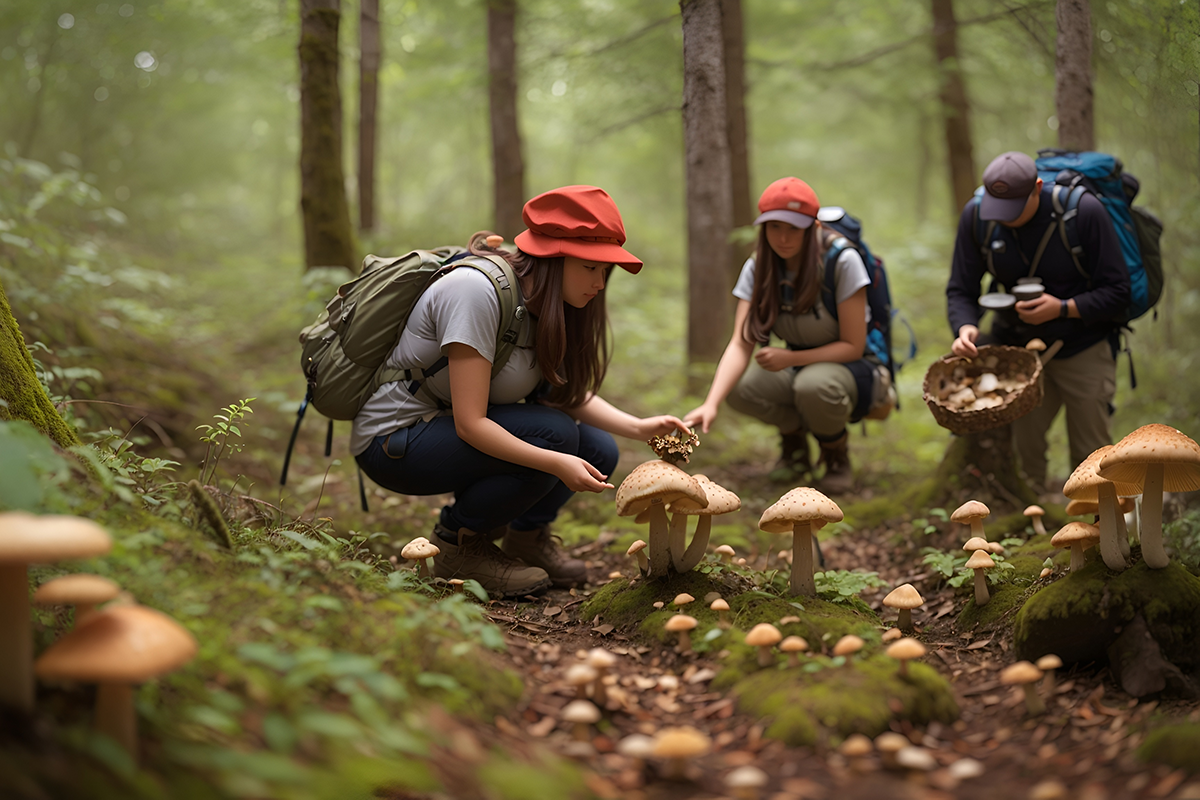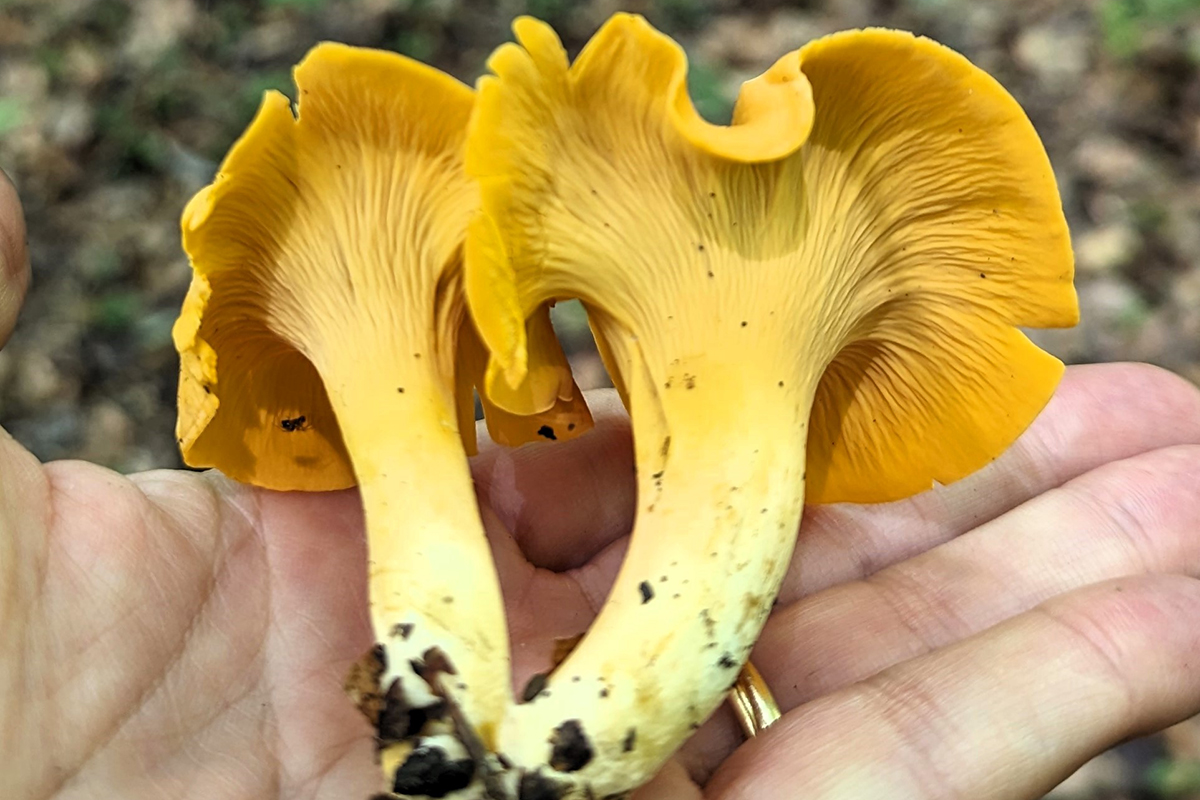

DISCLAIMER: Before harvesting and consuming any wild mushrooms or items foraged from the wild, be sure to fully research which ones are safe and unsafe. Mushrooms can be deadly, and easily confused. Also research potential side effects and consult your doctor about any possible interactions with medications you’re taking.
Videos by Outdoors
Fungus foraging isn’t just for homesteaders and hippies—anyone who enjoys the great outdoors can benefit from finding their own shrooms in the wild.
History of Mushrooms in Society
Mushroom foraging might just be gaining traction in the U.S. within the past few years, but people have been experimenting with species of fungus across the globe long before it became trendy.
From psychedelics incorporated into religious practices to nutritious fungus filling up the dinner table to medicinal varieties treating serious health conditions, mushrooms have been a staple in many cultures for centuries.

According to “Mushroom: A Global History,” ancient civilizations incorporated hallucinogenic mushrooms into spiritual practices as early as 10,000 B.C., and many Asian countries have been treating infections, diseases, and cancers with medicinal mushrooms for generations.
But eating mushrooms wasn’t always successful. Charles VI, Holy Roman Emperor, reportedly died in 1740 after being served death cap mushrooms.
Likely due to the uncertainty that comes with consuming fungus, the western world has generally been slower to adopt the use of mushrooms in any form. Americans only began cooking with them in the late 1800s after following the lead of the French.
Today, however, a wide variety of mushrooms are common in pantries across the country, and more people than ever are hitting the trail to find their own.
Common Wild Mushrooms and Their Uses
North America is home to hundreds of wild mushroom species that are safe to consume, but varieties and seasons will vary by region and weather.
Debbie Naha-Koretzky, known as the “Wild Edibles Lady,” is a licensed dietitian nutritionist, Pennsylvania master naturalist, and the author of Foraging Pennsylvania and New Jersey. She uses her background and training to lead educational programs on foraging with “a unique approach to appreciating wild foods.” Naha-Koretzky says beginning foragers should start with the more “foolproof” species of edible mushrooms that are easier to identify.
According to Naha-Koretzky, these include:
Morels

Found in most states throughout the U.S. between March and September, the morel is one of the most popular and coveted among outdoor enthusiasts. Morels grow best in undisturbed areas with moist, quality soil and plenty of sunlight. They typically begin to sprout up when soil temperatures hit 50 degrees Fahrenheit following damp weather.
Many foragers look for dandelions as a sign morels are soon to follow in the spring. The mushrooms sport a honeycombed cone-shaped cap, somewhere between a light yellow and deep brown. Featuring a pleasant earthy flavor, these versatile mushrooms stand up well to grilling, sautéing, and roasting. Morels pair well with red meat, poultry, seafood, or pasta. With a high vitamin D content, they’re also loaded with antioxidants, boast anti-inflammatory properties, and can help boost the immune system.
Chicken of the Woods

These vibrant mushrooms can spring from newly dead trees as early as April and as late as November, depending on where you’re foraging. They often grow in large clusters, so you can be set for several meals if you find just one fallen hardwood hosting chicken of the woods.
The mushrooms range from a yellow-orange to orange-red with wavy yellow edges. The hardy mushrooms have a meaty texture and a chicken-like flavor with a hint of lemon, making them a great meat substitute. Their prebiotics help support gut health and optimal digestion. Many foragers and natural practitioners also praise chicken of the woods for their hormone-balancing, anti-carcinogenic, and antibacterial properties.
Chanterelle

Most common from the late summer to the early fall, chanterelles are easy to spot with their bright yellow or orange caps in typically large clusters. They grow well around hardwood trees in mature forests with moist soil. Foragers often sniff them out, thanks to the chanterelle’s apricot-like scent. Chanterelles don’t taste like the sweet fruit, though—they feature a rich, earthy flavor and are especially delicious when pan-sautéed.
Chanterelles are an excellent source of vitamins B,C, and D, as well as minerals such as copper, potassium, and selenium. They’re well-known for their anti-viral and anti-cancer properties.
Lion’s Mane

These odd-looking mushrooms live up to their name—they’re made up of long white “teeth” that hang down from a stalk. Lion’s manes usually grow from mid-summer all the way through fall, high up on hardwood trees. When cooked, they’re tender with a mild, sweet flavor that many compare to shellfish.
Yet, many people pick lion’s manes for their potent health benefits rather than their taste. These mushrooms have long been used by alternative practitioners to treat anxiety, depression, and tumors. They can help improve brain function and promote healthy hair, skin, and nails.
Turkey Tail

These medicinal mushrooms, which get their name for their resemblance to the wild turkey’s fan, grow year-round in most areas. Turkey tails typically grow on trunks, branches, or stumps of hardwood trees, but you might find them on conifers too. Most foragers administer turkey tail in the form of a tincture, tea, or encapsulated powder to benefit from the mushroom’s anti-cancer and immunity-boosting properties as well as their calcium, potassium, and magnesium content.
Other common mushrooms in wild parts of the country include giant puffballs, shaggy manes, oyster mushrooms, hen of the woods, black trumpets, pheasant back, and king boletes. As you gain more experience in the field, you can branch out into foraging for more types of mushrooms.
Best Practices for Mushroom Foraging
Before you begin foraging, keep a few important tips in mind.
Know When and Where to Go
Unless you have a reliable honey hole on private land, foraging for mushrooms can be a time- and labor-intensive process. To make the most of your outings, keep a careful eye on local conditions and know what types of locations to look for, based on the specific mushrooms you’re targeting. Hit the woods at the right time, and you could hit the jackpot.
Do Your Research and Be Informed
While some mushrooms are easily discernible and no true lookalikes exist, others are often confused with similar-looking varieties that can be harmful or poisonous. False morels, for example, look a lot like the real deal but could potentially cause vomiting, seizures, coma, or even death if eaten in certain quantities.
“Be meticulous about identification,” Naha-Koretzky said. “There are many factors to consider, such as shape, size, color, etc. Does the cap have pores underneath, or perhaps there are gills or maybe teeth? Is the mushroom hollow? Some mushrooms have a characteristic smell. Pheasant back is said to smell like cucumber, while chanterelles are described as smelling like apricot.”
Read up on the types of mushrooms you plan to forage for and review photos to learn how to distinguish between good and deadly mushrooms. It will take some time to master this skill, so consider going with an experienced forager or checking with experts before eating your finds.
“I always remind people not to rely on just one person, book, or website for information,” Naha-Koretzky said. “Cross-check various sources. Buy a few good field guides and check every detail for the mushroom you are studying.”
She also suggests connecting with a local mushroom club to take advantage of educational and foraging events. “Seeing a mushroom in its natural habitat is very helpful,” she said. “Remember: When in doubt, don’t eat it!”
Pick Them Correctly
When you locate a target mushroom, inspect it before you pick it. If it’s past its prime, riddled with bugs, or full of holes, leave it behind—only take quality specimens with you. And be careful when you pick them.
“When you harvest an edible mushroom, it’s best to leave most of the dirt and debris behind in the field,” Naha-Koretzky said. “Cut the dirty base off.”

Be Considerate and Responsible
Coming upon a treasure trove of mushrooms in the wild can be exciting, but don’t be greedy. Pick what you can use in a reasonable amount of time and leave the rest for other foragers.
Get Them Clean
Before using your mushrooms, properly clean them with fresh water. “At home, trim off any damaged sections or parts that have embedded dirt,” Naha-Koretzky said. Some mushrooms stand up well to long soaks, but other more delicate varieties do best with careful rinsing just before cooking. “The cleaning method depends on the type of mushroom,” she said. “Rinsing with cold water is always a good idea.”
Naha-Koretzky suggests breaking loose cluster mushrooms, such as hen of the woods, into smaller pieces to rinse, then using a salad spinner to remove excess water and allowing them to dry on a towel before cooking or refrigerating.
“Chanterelles can be rinsed or swished in a bowl of cold water,” she said. “Hollow species like morels and black trumpets should be cut in half top to bottom then rinsed.”
Use Them the Right Way
While morels and chanterelles make for tasty dishes, turkey tails are typically better tolerated in tea or tincture form. Make sure you’re using each mushroom right to get the most benefits and enjoyment out of it.
“All mushrooms should be cooked before eating,” Naha-Koretzky said. “Cooking makes mushrooms easier to digest. It also denatures toxins naturally found in edible mushrooms and kills pathogens. Look up recipes for the specific type of mushroom.”
While mushrooms should be thoroughly cooked before eating to ensure safety, you don’t want to overcook them into a mushy mess.
Be Cautious
Before consuming any wild mushrooms, be sure to research potential side effects (gastrointestinal issues can be common with some types) and consult your doctor about any possible interactions with medications you’re taking.
“It is advised to eat only a small sample first when trying a new mushroom or any new food,” Naha-Koretzky said. “Even if the mushroom is an edible species, you may have an intolerance.”
If you’re interested in foraging for mushrooms, now is a great time to get started with this fun hobby that gets you out in the fresh air, puts food on the table, and might even replace pills in your medicine cabinet.










I think more people would forage for mushrooms if there was a place you could confirm they are not poisonous varieties. The problem for beginners/newcomers is differentiating the varieties. Many look similar to me.
In North Carolina a number of mushrooms are deadly, many more will make you so sick that you would wish you were going to die. It is not advisable to tell folks to pick their own mushrooms.
The images in this entire article is AI generated. You will probably die if you follow the mushroom picking directions in this article